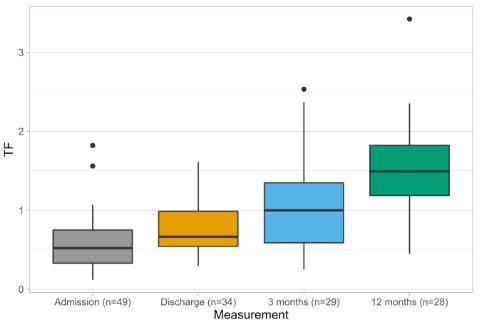Abstract
Introduction: We hypothesize that diaphragm function has a long recovery time after COVID-19 hospitalization, and may play a role in post-COVID syndrome.
Aim and objectives: To assess diaphragm function during COVID-19 hospitalization and during recovery.
Methods: We conducted a prospective single-center cohort study in 49 patients enrolled, of which 28 completed one-year follow-up. Diaphragm function was assessed using ultrasound measuring of diaphragm thickening fraction (TF) within 24 hours after admission, after 7 days of admission or at discharge, whichever came first, and three and twelve months after hospital admission.
Results: Estimated mean TF increased from 0.56 (95% CI 0.46-0.66) on admission to 0.78 (95% CI 0.65-0.89) at discharge or seven days after admission, to 1.05 (95% CI 0.83-1.26) three months after admission to 1.54 (95% CI 1.31-1.76) twelve months after admission. The improvements from admission to discharge, 3 months and 12 months were all significant (LMM; p=0.020, p<0.001, and p<0.001, respectively) and the improvement from discharge to three months follow-up was borderline significant (p<0.1).
Conclusion: TF was impaired during hospitalization for COVID-19. During recovery in hospital and up to one-year follow-up, TF improved, suggesting a long recovery time of the diaphragm. Diaphragm ultrasound may be a valuable modality in the screening and follow-up of (post-)COVID-19 patients for diaphragm dysfunction.
